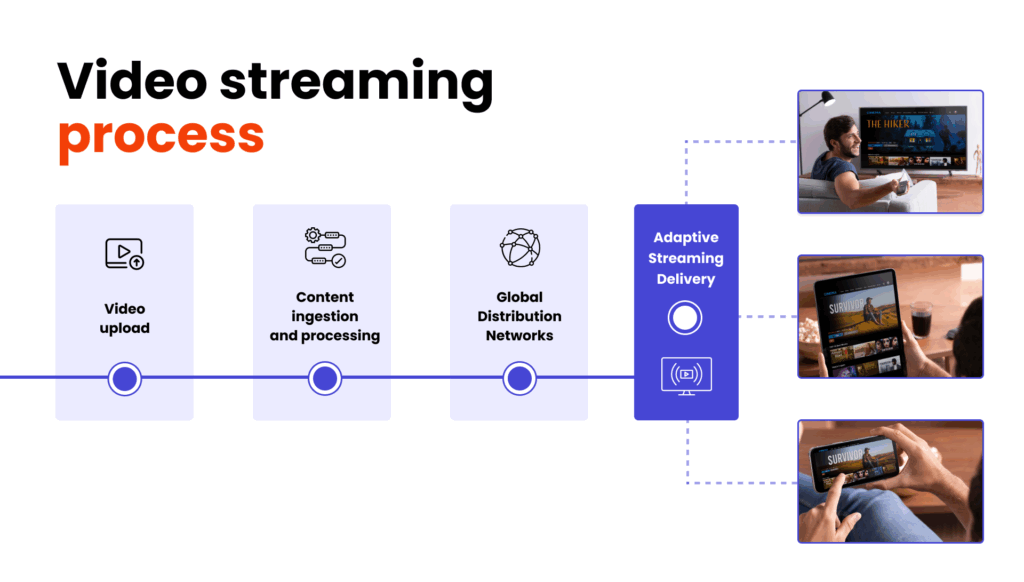What is cloud streaming and why is it reshaping media delivery?
You’ve just finished production on your latest series and your stakeholders want it to be available worldwide by next week. In the old days, this would have meant frantically calling data centre vendors, setting up encoding servers across three continents and praying that nothing broke during the weekend launch. Now? You upload to the cloud and grab a coffee while algorithms handle the rest.
The global video streaming market size was estimated at USD 129.26 billion in 2024 and is projected to reach USD 416.8 billion by 2030. That’s not just growth – that’s a complete industry transformation happening in real-time.
This guide breaks down everything you need to know about cloud streaming: how it works behind the scenes, why it’s becoming the go-to choice for innovative media companies and what it means for your content strategy.
What is cloud streaming?
Cloud streaming is a technology that delivers content directly from remote servers to devices over the internet, eliminating the need for local storage or processing. Instead of downloading files to your device, everything happens in the cloud – powerful servers handle all the work and send the results directly to your screen.
Whether it’s video content, interactive games, live broadcasts, or other digital media, streaming technology handles all content processing and optimisation on server infrastructure before transmitting to user devices in real-time. Think of it as having a supercomputer do all the heavy lifting while your device simply displays the results.
This means users can access content through any device with an internet connection – laptops, smartphones, and smart TVs – regardless of their hardware specifications. A basic smartphone can stream high-quality video just as an expensive laptop can, because the processing occurs remotely on powerful servers, not on your device.
Cloud streaming fundamentally changes how content reaches audiences by shifting the computational burden from individual devices to centralised server networks. This provides instant access to vast content libraries without the traditional constraints of device storage or processing power.
Major streaming services from companies like Netflix and Microsoft demonstrate the maturity and scalability of this technology, delivering content to millions of users simultaneously while maintaining consistent performance and quality. The infrastructure supports everything from video-on-demand to live broadcasts, with adaptive streaming ensuring optimal quality across varying network conditions.
Note: While cloud streaming encompasses a wide range of content, this article will focus specifically on video streaming.
How cloud streaming works
Cloud streaming operates through a sophisticated network of distributed servers that handle content processing, storage, and delivery to end users. It’s essentially like having a global production team that never sleeps, working behind the scenes to ensure your content reaches viewers perfectly, every time.

- Video upload: Your video content is uploaded to the cloud streaming platform, where it’s immediately prepared for processing and global distribution.
- Content ingestion and processing: Streaming technology receives the original files and prepares them for distribution. Servers then encode and transcode the content into multiple formats and resolutions, creating adaptive bitrate streams that automatically adjust quality based on each user’s internet connection bandwidth and device capabilities.
- Global distribution networks: Cloud infrastructure leverages global server networks hosted in data centres worldwide, bringing content geographically closer to users to reduce latency and improve streaming quality. These distributed networks ensure that when someone accesses content, they’re connecting to the nearest available server, minimising the distance data must travel.
- Adaptive streaming delivery: During playback, the system continuously monitors network conditions and automatically adjusts the quality level to maintain smooth streaming. If a user’s internet connection slows down, the technology seamlessly downloads lower-resolution segments to prevent buffering. When bandwidth improves, it automatically increases quality again.
The entire video streaming process occurs transparently to users, who simply access content through their preferred device – whether it’s a laptop, smartphone, or smart TV. The cloud handles all the complex processing, storage, and delivery logistics, ensuring consistent performance regardless of device type or location.
Have questions about cloud streaming? Our team is ready to help!
Learn moreBenefits of video cloud streaming
Let’s be honest – cloud streaming isn’t just a nice-to-have anymore. It’s become essential for any organisation serious about video delivery. Here’s why smart companies are making the switch.
Seamless scalability and global reach
Remember when a viral video could crash your servers? Those days are over. Cloud infrastructure automatically scales to handle traffic spikes, whether you’re serving a thousand viewers or a million. The platform seamlessly expands capacity as your audience grows, without you having to predict demand or invest in hardware that might sit idle most of the time.
This distributed approach enables streaming services to serve millions of concurrent users while maintaining quality and reliability across diverse technology environments and geographical regions. As a result, your audience gets a flawless viewing experience, while you get to focus on creating content.
This flexibility means you can enter new markets without building regional infrastructure first. Launch in South East Asia on Monday, add European distribution on Tuesday – the cloud makes geographic expansion as simple as flipping a switch.
Enhanced accessibility across all devices
Your content works everywhere. Laptops, smartphones, tablets, smart TVs, gaming consoles – if it has an internet connection, it can stream your content perfectly. No more worrying about device compatibility or maintaining separate apps for different platforms.
This universal accessibility dramatically expands your potential audience while simplifying your technical requirements. One upload, infinite viewing possibilities.
Cost-effectiveness and financial flexibility
Cloud streaming transforms video delivery from a massive capital expense into a predictable operational cost. Instead of buying servers, maintaining data centres, and hiring technical teams, you pay only for what you actually use.
This model particularly benefits companies with fluctuating demand. Scale up during peak periods, scale down during quiet times, and only pay for the resources you consume. It’s like having enterprise-grade infrastructure without the enterprise-grade price tag.
Enterprise-grade security and compliance
Cloud platforms incorporate enterprise-level security measures that most organisations couldn’t implement independently. We’re talking encryption, access controls, digital rights management, and dedicated security teams monitoring everything 24/7.
Major cloud providers maintain compliance with international regulations like GDPR and industry-specific standards, handling the complex regulatory requirements so you don’t have to become a compliance expert.
Optimised performance and adaptive delivery
Advanced algorithms continuously optimise your content delivery, automatically transcoding videos into multiple formats and quality levels. Content Delivery Networks distribute your content from geographically dispersed servers, reducing latency and eliminating buffering issues for global audiences.
This adaptive approach maintains smooth streaming experiences regardless of internet connection quality or device capabilities, maximising viewer satisfaction and keeping audiences engaged with your content.
Simplified operations and reduced IT burden
Cloud streaming eliminates the headache of managing physical infrastructure, server maintenance, and software updates. Your IT team can focus on strategic projects rather than keeping servers running, while automatic updates ensure your platform stays current with the latest features and security patches.
This operational simplification dramatically reduces time-to-market for new content and removes the technical expertise barrier that previously made professional-grade streaming platforms accessible only to large organisations with dedicated technical teams.
Ready to transform your video streaming strategy?
Cloud streaming represents the future of video delivery, offering unprecedented scalability, global reach, and cost-effectiveness for companies ready to modernise their content distribution. Whether you’re looking to launch a new streaming service, expand to global markets, or optimise your existing video delivery infrastructure, the technology has matured to support even the most demanding requirements.
At Spyrosoft, we’ve helped media and entertainment companies transform their video content management and delivery strategies through proven cloud streaming implementations.
Check our media and entertainment offer to learn how we can help you create a competitive advantage through modern content delivery solutions.
About the author
Contact us





![[thumbnail] media and entertainment - android tv guide](https://spyro-soft.com/wp-content/uploads/2025/06/thumbnail-media-and-entertainment-android-tv-guide-1024x655.png)